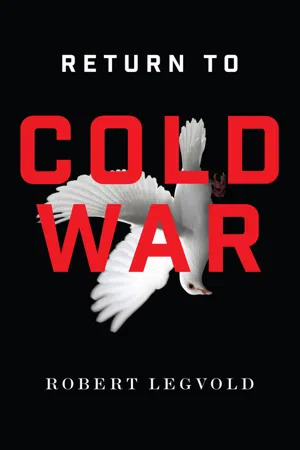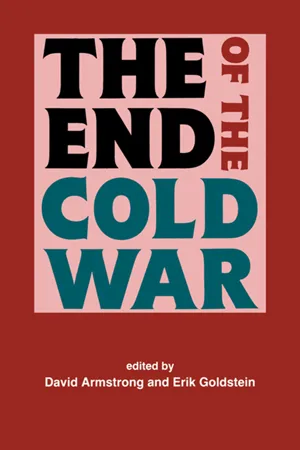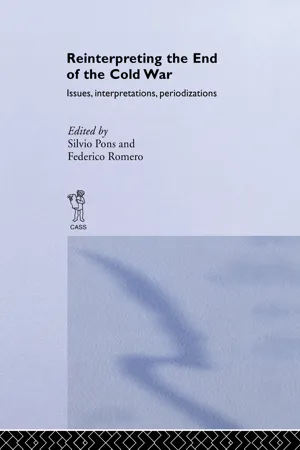Cold War
The Cold War was a period of geopolitical tension and rivalry between the United States and its allies on one side, and the Soviet Union and its allies on the other, following World War II. It was characterized by ideological, political, and military competition, but without direct armed conflict between the two superpowers. The Cold War had a significant impact on global politics and international relations.
7 Key excerpts on "Cold War"
- eBook - ePub
The Cold War
An International History
- David Painter(Author)
- 2002(Publication Date)
- Routledge(Publisher)
...The Cold War was an economic as well as a military and political conflict, and geopolitical alignment almost always involved a choice of economic system. The interconnected nature of international issues and domestic dynamics was one of the most distinctive features of the Cold War. During the Cold War, the direction of social and economic development was the subject of great contention. The potential impact of internal political alignments on the global balance of power invested domestic political struggles with international political and strategic significance. Changes in the balance of political forces both within and among nations took place throughout the Cold War and played a major role in initiating, prolonging, and finally ending the conflict. The collapse of communism as an ideology paralleled the decline in the Soviet strategic position. Highly regarded by many at the end of World War II, the appeal of communism and the Soviet model of development declined sharply in most of the world over the course of the Cold War. Repression in the Soviet Union, Eastern Europe, and the People’s Republic of China tarnished communism’s image. In the 1960s and 1970s some European communist parties attempted to reform themselves and to divorce communism from the harsh reality of Soviet (and Chinese) practice. These efforts failed to gain sufficient support to wrest leadership of world communism from the Soviet Union and the PRC. The faltering Soviet economy further discredited communism’s appeal, as did growing international awareness of human rights and environmental abuses inside the Soviet Union, Eastern Europe, and the PRC. Transnational ideological conflict was closely related to the development of national economies and the evolution of the global economy. Economic changes restructured power relationships among as well as within nations...
- eBook - ePub
War, Peace and International Relations
An introduction to strategic history
- Colin S. Gray(Author)
- 2013(Publication Date)
- Routledge(Publisher)
...Ideologically and geopolitically, the United States and the Soviet Union truly were enemies. Their reciprocated perceptions of enmity were correct. It was but a short step from enemy identification to the anticipation of threat, and then to the suspicion of malign conditional intention to take hostile military action. By mid-1950, at the latest, both sides had added military threat to the political menace that their ideologies defined for them. In common with all wars, the Cold War was a duel. It was a protracted struggle that had periods of both greater and lesser political tension. Above all else, though, it proceeded by interaction. This popular, rather obvious, point lends itself to misunderstanding. Not everything about East–West relations from 1947 to 1989 can be explained in terms of interaction. The two superpowers, with their friends and allies generally in policy attendance, though sometimes in advance or behind on policy, behaved according to their own socio-cultural characters and in ways that fitted what each understood to be its geopolitical interests. However, that behaviour was shaped by a context of overarching conflict, and it was always liable to influence from initiatives emerging from the other side. Despite the fact that neither party desired war, the Cold War was extraordinarily dangerous. It is probably just as well that a non-war outcome was the product of several mutually supporting factors, because the protagonists played with the most deadly of fires for forty years. The armed forces of East and West were permanently in contact on land in Central Europe, and they frequently harassed each other at sea and in the air. Also, the great engines of nuclear destruction that both sides constructed could not be 100 per cent proofed against accident, technical malfunction, command failure, launch by miscalculation or simple bad luck...
- eBook - ePub
- Robert Legvold(Author)
- 2016(Publication Date)
- Polity(Publisher)
...Two, however, help better than others to unscramble the tangle of interpretations vying to explain the new Cold War. The first is the venerable and widely accepted conviction that the Cold War was a battle between political and economic systems, underpinned by fundamentally different values, goals, and ontologies. Within this argument the principal contention was over the latter, over the ideological element, and whether it played a primary or secondary causal role. Less conspicuously, a second area of disagreement eventually emerged related to the primary sphere within which the inter-systemic rivalry took place. Scholars looking back over the whole of the Cold War charged that mainstream analysts, particularly international relations theorists, had gotten it wrong by stamping it Euro-centric – that is, as a strategic contest between the United States and the Soviet Union over the fate of the international system’s European fulcrum – when, in fact, the Cold War’s active theater was the Third World (Westad, 2007). If the Cold War, as Fred Halliday (1999) argued, was as much a socio-economic contest for the hearts and minds of much of the globe as an ideological and geopolitical test of wills, then the fluid environment where it raged and, indeed, the point from which it ricocheted back into the anxiety-ridden consciousness of US and Soviet leaders was the vast expanses of a roiling postcolonial world. Halliday, to put a fine point on it, suggested that US “national security doctrines – from Truman to Reagan – were less about responding to Soviet geopolitical maneuvering and more concerned with responding to the geopolitical consequences of localized revolutionary crises” (Saull, 2011). That was inside the argument. Outside of it, the opposing school insisted that the clash of political and economic systems mattered less than a simple, classical slugfest over power. The clash was merely the tissue covering the real muscle controlling events...
- eBook - ePub
- Preston Jones(Author)
- 2013(Publication Date)
- Research & Education Association(Publisher)
...Though the UN’s responsibilities would extend beyond disarming aggressor nations, that would be one of its founding ideas. And partly in recognition of the status of the United States as a new world power, the UN’s headquarters were based, and remain, in New York. Another signal of American power was the Bretton Woods Agreement of 1944, which made the U.S. dollar the world’s reserve currency. The Korean War (1950–1953) ended almost where it began: the armistice line of June 1953 straddled the thirty-eighth parallel, which, after the Second World War, had divided communist North Korea from noncommunist South Korea. Still, into the early twenty-first century, the war had not formally ended. The boundary between the Koreas remained the most heavily militarized in the world. The Korean War was one of many conflicts of the Cold War (1945–1991). The term Cold War usually refers to a decades-long struggle for global mastery between the two major powers to emerge from the Second World War—the United States and the Soviet Union—along with their allies. (Countries that resisted alignment with either power were referred to collectively as the Third World.) More broadly, it refers to a global war between the ideologies of communism and democracy, though anticommunists who gained the support of the United States were frequently not interested in democracy. The Cold War world was a nasty one; the United States felt compelled to ally itself with unsavory regimes whose only virtue was their anticommunist politics. The standoff between the United States and the Soviets began in the immediate aftermath of the war (though the roots of the Cold War go back much further). The Soviets had captured Berlin and occupied East Germany, losing tens of thousands of soldiers in the process. The Allies—the British (including the Canadians), Free French, and Americans—occupied West Germany, and as part of an agreement among the Allies they also acquired occupation zones in Berlin...
- eBook - ePub
- David Armstrong, Erik Goldstein, David Armstrong, Erik Goldstein(Authors)
- 2013(Publication Date)
- Routledge(Publisher)
...The Cold War: The Historical Context RICHARD LANGHORNE To read the existing literature on the Cold War, even ignoring the purely polemical, might certainly lead an interested but inexpert reader to suppose that there was a vast confusion both about when and why it began, and when and why it ended - indeed even as to whether it did not abate and then recur. Naturally, certain lines of thought predominate. The idea that the Cold War was essentially a result of the immediate post-second world war situation is fairly common ground. That it either ended or slowed in Khruschev’s time is at least as acceptable a view as that it has ended, or is ending, now, in response to Gorbachev’s reformist policies, or their consequences for the USSR. The recent changes in Eastern Europe have not only had the effect of proposing yet another end to the Cold War era, but also of pointing up the long period during which Russian predominance lasted. This can lead to an oversimplification by which the Cold War period is simply equated with that of superpower dominance — a simplification all too easily espoused by particular political groupings and their public supporters. Difficult as they can be to disentangle, there remains the risk of confusing cause with consequence. The state of affairs in Eastern Europe was primarily caused by the preponderance of Russian power in the region at the end of the war. The precise form that preponderance took was the consequence of the American response to it...
- eBook - ePub
Reinterpreting the End of the Cold War
Issues, Interpretations, Periodizations
- Silvio Pons, Federico Romero, Silvio Pons, Federico Romero(Authors)
- 2014(Publication Date)
- Routledge(Publisher)
...Often, in fact, that blindingly obvious conclusion generates the putative premise of the argument, and not the other way around. I have polemicized against this way of looking at the problem elsewhere and will only point out now that a simple, ‘epochal’ conception, all-encompassing as it tends to be, occasions serious problems of demarcation. What exactly is the Cold War and where did it take place? After a metaphorical while, it turns out to be everything and nothing: suburban life in Los Angeles (why not?), educational reform in rural Australia, and decisional intrigue in the Pentagon. For better or worse, my argument goes in the opposite direction, towards, in the spirit of a delimiting critique, ever greater specificity. The Cold War as a concept, for one thing, should be kept analytically distinct from origins and effects. As initially a peculiar projection of US power, it was never everything that happened between the United States and the USSR in the post-war period up to 1963 (or 1989); it was a dominant, an overdetermining structure whose effects cut synchronically across a range of other levels and terrains. Similarly, from a diachronic perspective, its effects do not all come to an end in 1963. Thus, for example, the US escalation in Vietnam in 1965 was a residual (and catastrophically misconceived) Cold War policy; the massive intervention on behalf of the forces of violent reaction in the Dominican Republic that same year was, by contrast, Great Power management of a line already drawn. My chapter begins with a summary of the first (taxonomic) moment in the evolution of my view of the Cold War, followed by a reconsideration of the second moment, wherein I trace anew the genealogy of the Cold War through the decisive succession of non-dialectical outlooks, strategies and policies that came to characterize the US ‘way of being’ towards the world during and after World War II...
- eBook - ePub
International Relations since 1945
East, West, North, South
- Geir Lundestad(Author)
- 2017(Publication Date)
- SAGE Publications Ltd(Publisher)
...2 The Cold War in Europe, 1945–1949 Political Science and History In political science the study of international relations has been dominated by two basic general approaches, realism and liberalism. Realism was long the dominant approach. Its starting point was the anarchic nature of the international system, in the sense that the predominant consideration of each state was to protect its own security. You could never be certain what other states would do in the future. Therefore you had to prepare for the worst contingencies. In a world of sovereign states, international institutions mattered only on the margins. The international community differs from the domestic situation within individual nations in that there is no effective central power having more or less a monopoly of the use of force. No state was really willing to leave its primary security requirement to an international authority. The United Nations could perform some useful functions, but the Great Powers all insisted on having a veto to stop the new organization from undertaking actions contrary to their interests. The Soviet Union came to use its veto quite frequently. Since the Western powers dominated the UN, they long had less of a need to use their vetos. Conflicts are therefore inevitable in the international system. The normal state is rivalry rather than cooperation. Of course major powers can cooperate, but when they do so it is most often to face a joint threat. When the threat no longer exists, cooperation normally dissipates. In this perspective the antagonism between East and West is a new variation on a familiar theme. The coalition between the United States, the Soviet Union, and the United Kingdom was dissolved after Germany and Japan were defeated in 1945. A similar situation pertained after the Napoleonic wars and after the First World War...






